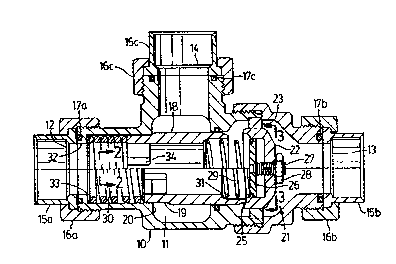Some of the information on this Web page has been provided by external sources. The Government of Canada is not responsible for the accuracy, reliability or currency of the information supplied by external sources. Users wishing to rely upon this information should consult directly with the source of the information. Content provided by external sources is not subject to official languages, privacy and accessibility requirements.
Any discrepancies in the text and image of the Claims and Abstract are due to differing posting times. Text of the Claims and Abstract are posted:
| (12) Patent: | (11) CA 2107522 |
|---|---|
| (54) English Title: | TEMPERATURE RESPONSIVE 3-WAY LINE VALVE WITH SHAPE MEMORY ALLOY ACTUATOR |
| (54) French Title: | ROBINET THERMOSTATIQUE A TROIS VOIES POSSEDANT UN ACTIONNEUR EN ALLIAGE A MEMOIRE DE FORME |
| Status: | Term Expired - Post Grant Beyond Limit |
| (51) International Patent Classification (IPC): |
|
|---|---|
| (72) Inventors : |
|
| (73) Owners : |
|
| (71) Applicants : | |
| (74) Agent: | SMART & BIGGAR LP |
| (74) Associate agent: | |
| (45) Issued: | 1997-12-30 |
| (22) Filed Date: | 1993-10-01 |
| (41) Open to Public Inspection: | 1994-09-05 |
| Examination requested: | 1993-10-01 |
| Availability of licence: | N/A |
| Dedicated to the Public: | N/A |
| (25) Language of filing: | English |
| Patent Cooperation Treaty (PCT): | No |
|---|
| (30) Application Priority Data: | ||||||
|---|---|---|---|---|---|---|
|
The invention provides a self-contained automatic
temperature-responsive three way line valve. A tubular valve
member is axially slidable between first and second limit
positions for selectively directing fluid from an inlet port
to a first outlet port or a second outlet port. The valve
member is disposed between a pair of opposed compression
springs, one being a conventional spring biasing the valve
member to the first limit position and the other being an SME
spring which overcomes the bias of the first-mentioned spring
when the fluid exceeds a given temperature.
Vanne automatique à trois voies sensible à la température. Un élément de robinetterie tubulaire glisse dans le sens axial entre les première et deuxième position de fin de course pour acheminer le fluide d'un orifice d'entrée vers un premier ou un deuxième orifice de sortie. L'élément de robinetterie est placé entre deux ressorts de pression opposés, l'un étant un ressort classique qui pousse l'élément de robinetterie à la première position de fin de course et l'autre étant un ressort à effet mémoire qui surpasse le premier ressort si le fluide dépasse une température donnée.
Note: Claims are shown in the official language in which they were submitted.
Note: Descriptions are shown in the official language in which they were submitted.

2024-08-01:As part of the Next Generation Patents (NGP) transition, the Canadian Patents Database (CPD) now contains a more detailed Event History, which replicates the Event Log of our new back-office solution.
Please note that "Inactive:" events refers to events no longer in use in our new back-office solution.
For a clearer understanding of the status of the application/patent presented on this page, the site Disclaimer , as well as the definitions for Patent , Event History , Maintenance Fee and Payment History should be consulted.
| Description | Date |
|---|---|
| Inactive: Expired (new Act pat) | 2013-10-01 |
| Inactive: IPC from MCD | 2006-03-11 |
| Grant by Issuance | 1997-12-30 |
| Pre-grant | 1997-09-19 |
| Inactive: Final fee received | 1997-09-19 |
| Notice of Allowance is Issued | 1997-08-14 |
| Letter Sent | 1997-08-14 |
| Notice of Allowance is Issued | 1997-08-14 |
| Inactive: Status info is complete as of Log entry date | 1997-08-11 |
| Inactive: Application prosecuted on TS as of Log entry date | 1997-08-11 |
| Inactive: IPC assigned | 1997-07-23 |
| Inactive: IPC removed | 1997-07-23 |
| Inactive: First IPC assigned | 1997-07-23 |
| Inactive: Approved for allowance (AFA) | 1997-07-21 |
| Application Published (Open to Public Inspection) | 1994-09-05 |
| All Requirements for Examination Determined Compliant | 1993-10-01 |
| Request for Examination Requirements Determined Compliant | 1993-10-01 |
There is no abandonment history.
The last payment was received on 1997-07-18
Note : If the full payment has not been received on or before the date indicated, a further fee may be required which may be one of the following
Please refer to the CIPO Patent Fees web page to see all current fee amounts.
Note: Records showing the ownership history in alphabetical order.
| Current Owners on Record |
|---|
| MAIER PERLMAN |
| JAMES M. BELL |
| RICHARD L. MARTIN |
| COLIN A. MCGUGAN |
| Past Owners on Record |
|---|
| None |